One thing I know for sure. Not all cruises are created equal. I have long eschewed voyages on behemoth cruise ships that carry up to 6,000 passengers and offer on-board amenities like water slides, rock-climbing walls, and miniature golf. Likewise, I have no interest in glitzy ports where the focus is on shopping, or on shore excursions that offer bungee jumping or zip lining. As a traveler who thrives on cultural immersion, I want to learn about the history of a destination, sample authentic cuisine, and talk to locals who can share their beliefs, traditions, hopes, and aspirations. After my two-week French Polynesia cruise, I can honestly say that nobody does that better than Aranui.
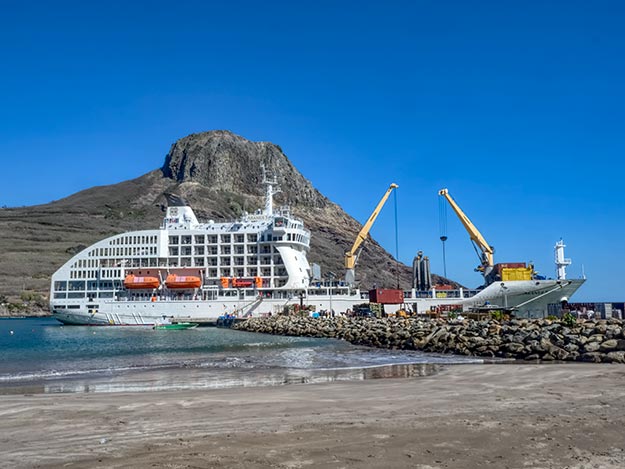
The Aranui 5 is operated by Compagnie Polynesienne de Transport Maritime (C.P.T.M.), a third-generation maritime company that was founded as a freight service in 1954 by the patriarch of the Wong family from Tahiti. The firm’s original ship, Aranui I, supplied and conducted trade between Tahiti (located in the Society Island group) and the Tuamotu and Gambiers Archipelagos, three of the five island groups that comprise French Polynesia. In 1978, the company added a commercial line that served the Marquesas Archipelago and in 1984 the Aranui began to offer cruises. Half of the ship was converted into 108 passenger cabins and common areas, while the other half was reserved for freight operations. Today the company’s fourth vessel, the Aranui 5, still delivers supplies to all six of the inhabited islands in the Marquesas. Over the past 34 years, it has helped revitalize the long forgotten Marquesan culture and contributed to the local economy by introducing these islands to more than 45,000 travelers.
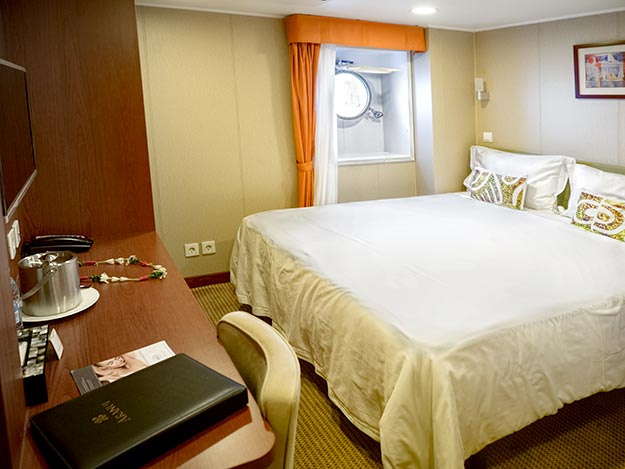

Recent DNA testing has proven that Polynesians originally came from Taiwan (one of the original tribes rather than Chinese ethnic groups that later settled on Taiwan). The first migrants made their way to Tonga and Samoa, becoming the “old Polynesians.” Eventually they explored further, reaching French Polynesia around A.D. 900, followed by Easter Island around 1200 and finally New Zealand about 1350.
These master navigators carved long outrigger canoes from giant tree trunks that would accommodate many paddlers. Ancient Polynesians could read the stars, which they believed to be the “eyes of the ancestors” because the constellations showed the way. When Scorpio – the “Hook of Tahiti” – appeared in the night sky, they sang a special song dedicated to it. When the next constellation appeared, they would switch to its song. During cloudy weather, they scrutinized the flights of seabirds. Some experts also believe they transported pigs in their canoes because pigs could smell land, just like they can smell truffles. Whenever the Polynesian explorers didn’t know which way to go, they’d put a pig in the water. It would sniff the air and swim in the direction of land. Between the stars, birds, and pigs, they managed to discover the tiny islands that dot the vast Pacific.
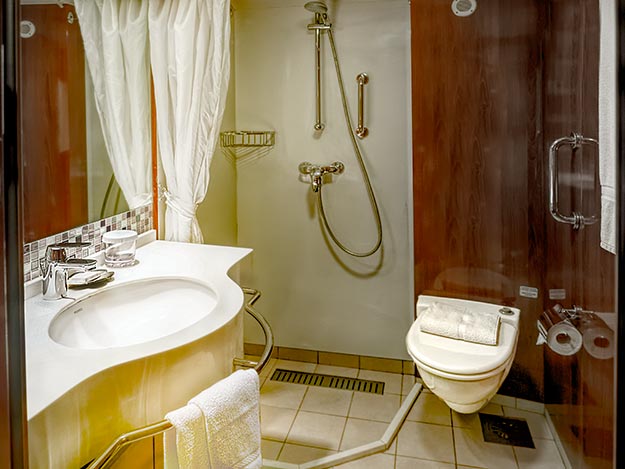
Dogs, chickens, and, unintentionally, rats were also carried in their long canoes, as were Pandanas plants, the leaves of which were used for weaving everything from roofs to baskets to hats. Taro, breadfruit, and banana plants were brought for food. Still today one of the most important foods in Marquesas is breadfruit, which during frequent periods of extended drought is pounded into a fermented paste that can be stored in silos for years. However, the most important cargo carried by the Polynesians was a carved wooden Tiki, their equivalent of a god or higher power, which guided and protected them.
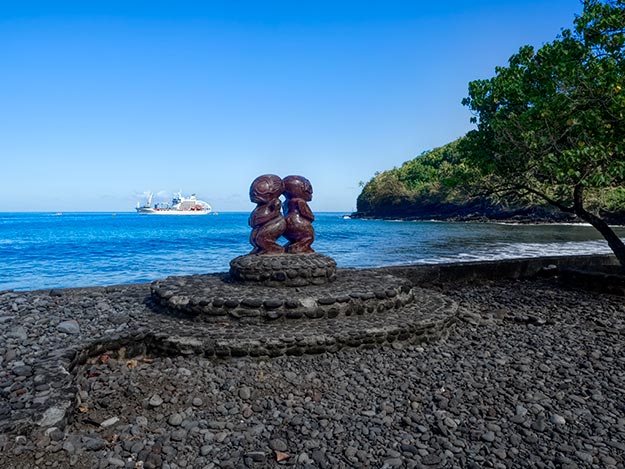
Tikis began as symbols carved into boulders and gradually evolved as statues that were carved out of stone, bone, or wood. Whenever a king or a great warrior died, the people built a great Tiki so that the mana (spirit) of the deceased would pass into it and protect the village. The most important and largest part of the Tiki is its head, which is the seat of spiritual power. Tikis also have big eyes and mouths – for seeing and communicating knowledge and to tell stories of the culture to the younger people. The Tiki’s hands often caress a big belly, which is considered the seat of all knowledge. A reflection of this belief is still found in the Polynesian saying, “learn by your gut.”
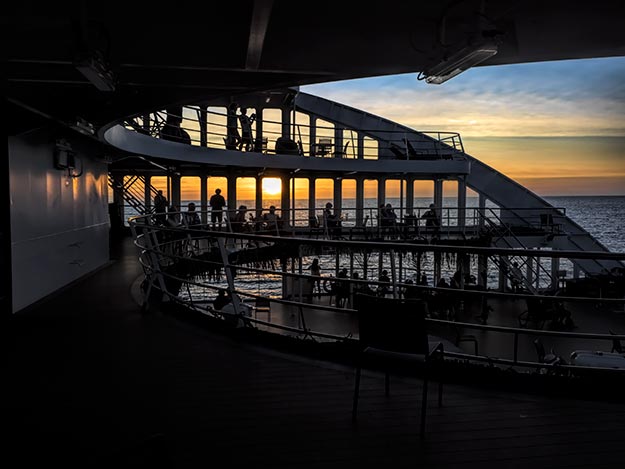
Early Polynesians thrived until the first Spaniard arrived in 1595. Álvaro de Mendaña was headed for the Solomon Islands when he ran out of food. Instead, he landed in the Marquesas. Mendaña claimed the islands and named them for his patron, the Marqués de Cañete. Polynesian tradition was to give freely but expect something back. The Spanish crew took the food they needed but gave nothing back, so the Polynesians, in their innocence, began helping themselves to things the Spaniards had. In retribution for what they considered theft, the Spaniards killed 200 of the locals.
Nearly 200 years later (1774) Capt. James Cook visited the Marquesas. At the time the population was estimated to be around 75,000. Over the next century and a half, the British, Chinese, Americans, Australians, and French all left their mark. In 1813, Commodore David Porter of the U.S. Navy built fortifications to protect the whaling trade, which provided oil and blubber that was used to light city streets. Unfortunately, he also got involved in a war between two Polynesian tribes, one of which offered to make him “big chief” if he would help. Porter set up his canons on hillsides and killed many, completely changing the Marquesan war culture. Previously, scores had been settled by two warriors who battled one another to the death. After the war, Marquesans turned to European trade in order to replace their wooden clubs with deadly arms.

Not long afterward, the British abandoned the East India Company, which resulted in Chinese markets being opened to Australian merchants. The Chinese sought Sandalwood for ceremonial offerings and Sandalwood trees grew abundantly in the Marquesas. The Australians wasted no time, harvesting the trees almost to extinction. They sold the fragrant wood to the Chinese, who paid them in tea, a highly valued luxury item in Australia.
Missionaries arrived in 1838 and began converting islanders to Catholicism with great success. Part and parcel of the conversion process was the suppression of the Polynesian culture. Priests banned traditional song, dance, and tattoos, as well as the Polynesian language. By the time France officially claimed the islands in 1870 and incorporated them into French Polynesia, the population was in steep decline. By the mid-1920’s, only 2,000 Marquesans remained on the six inhabited islands of the Archipelago. Many of the women had been rendered sterile by venereal diseases they had contracted from foreigners. Thousands succumbed to smallpox and measles, which had been brought to the islands by outsiders, but even those unaffected by disease had fallen into a malaise. No longer allowed to practice their culture due to religious restrictions, the Polynesians were spiritually lost.

Fortunately, Louis Rollin, a French doctor posted to the Marquesas in 1923, turned the tide against physical diseases. Around the same time a new bishop arrived who ended the cultural prohibitions. By the 1950’s, ancestral Polynesian songs, dance, tattoos, and language were enjoying a strong resurgence. With their culture back in place, the population began to grow once again. Today there are 9,000 Marquesans living on the six populated islands in the Marquesa Archipelago, and an additional 10,000 living in Tahiti.

Remarkably, I learned all of this from members of the crew, all native Polynesians, who took turns briefing us every evening in preparation for the following day’s activities. Cultural immersion began on day one of my French Polynesia cruise. Before we had even set sail from Tahiti, Aranui treated us to a traditional Marquesan dance performance on the pool deck. But the daily lectures paled in comparison to our itinerary, which provided unparalleled opportunities to learn about Polynesian culture during or visits to three of the territory’s archipelagos: the Tuamotu, Marquesa, and Society Islands.
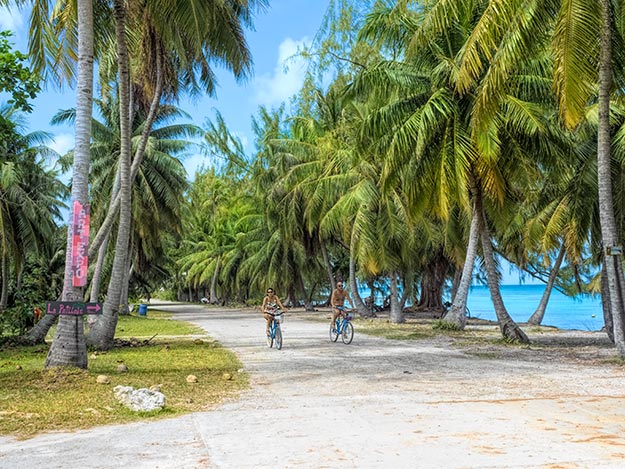
On Fakarava island in the Tuamotus I strolled down the main street in the village of Roulette. To my left, magenta and peach blossoms erupted on heavily bowed Bougainvillea branches. Behind the floral fences, simple cottages sat in the shade of stately palms. To my right, spotless white sand beaches gave way to endless turquoise seas. A mile up the road, all signs of development disappeared into a forest of gold and green palms.
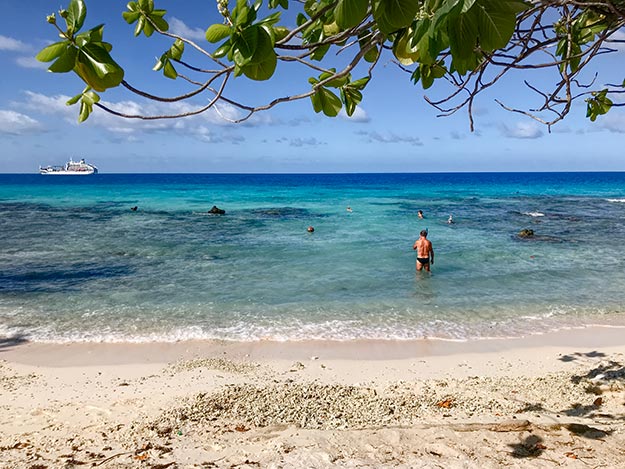
A second stop in the Tuamotus took us to Rangiroa Island, the only place in the world where black cultured pearls are grown. At the Gaugin Pearl Farm we learned that cultured pearls are five years in the making. The oysters must be raised for three years before they can be seeded, a measure that protects the species from over-harvesting. Once the oysters are three years old the seeding process begins.
Using a Japanese technique that took 20 yrs to develop, technicians open the oyster just enough to insert a small mirror to examine the interior color of the shell. If the color is acceptable, the technician makes a tiny cut in the mantle and inserts a 6mm nucleus made from a mussel shell indigenous to the Mississippi River. Mississippi mussels are used because their shells are extremely thick, thus they can be cut into small squares that are polished into balls. The shells of the oysters in Rangiroa are thin and break when cut.

At the same time, a tiny dot of oyster mantle is placed next to the nucleus. Without this, the oyster would see the nucleus as foreign material and reject it. Instead, the oyster thinks the nucleus is an irritant, such as a grain of sand, and begins coating it with layers of the pearlescent material. Two years later, the pearls are large enough to harvest. After the presentation, I watched with fascination as a technician extracted pearls from mature oysters and re-seed them with new nuclei. Hearing about it was fascinating, but to see the process in person was a once-in-a-lifetime opportunity.
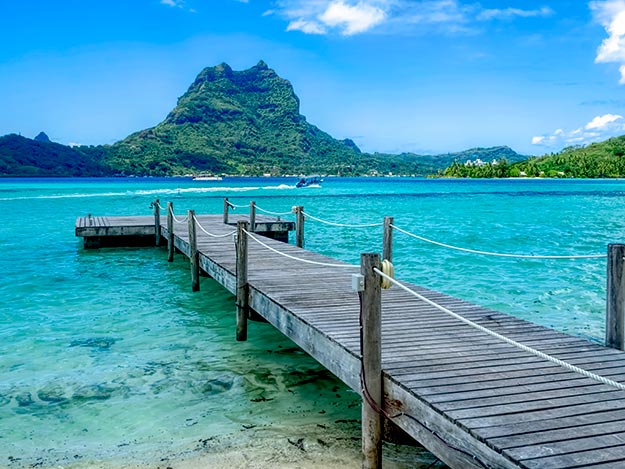
In the Society Islands, our port of call was Bora Bora. During one of our daily briefings, Aranui reps strongly recommended that we take the motorized canoe trip around the lagoon within the atoll. I took them at their word and was so glad I did! Bora Bora is perhaps most famous for thatch-roofed huts perched over crystalline aquamarine waters and indeed, we did see these. We also enjoyed a private picnic on Motu Tapu, a tiny island ringed by exquisite beaches with sugar-fine white sand. But the outrigger canoe tour will forever be imprinted in my memory.
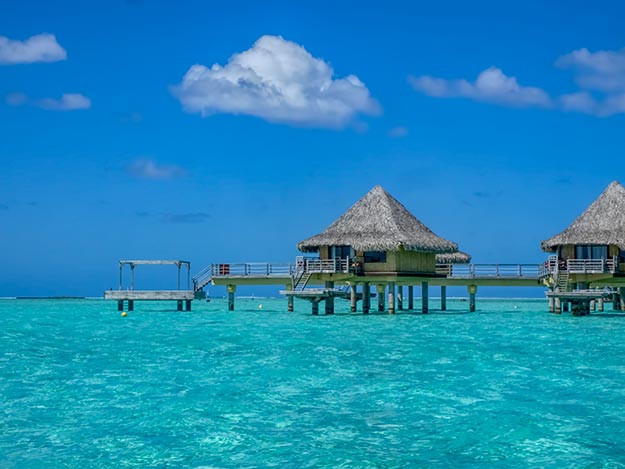
At one stop we climbed out into knee-deep water and sank into sand so soft and fine that we rubbed it all over our bodies, exfoliating dead skin. At a second location, we moored next to a colossal coral mound where giant eels darted from crevices and massive schools of tropical fish swirled around me. It was the third stop , however, that both terrified and made me giddy with joy. Our captain jumped into the water and began feeding schools of manta rays and black-tipped sharks. As they greedily snatched food from his palm, I slid into the water with mask and snorkel and swam toward the fray. Within seconds I was surrounded. I looked to the left and right through my mask. An entire family of sharks was circling me, round and round.
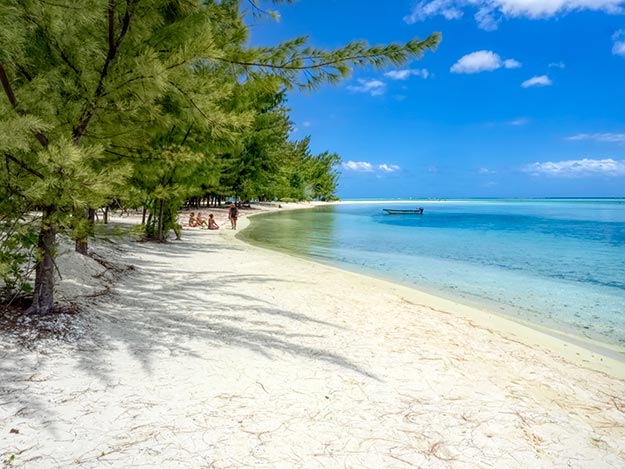
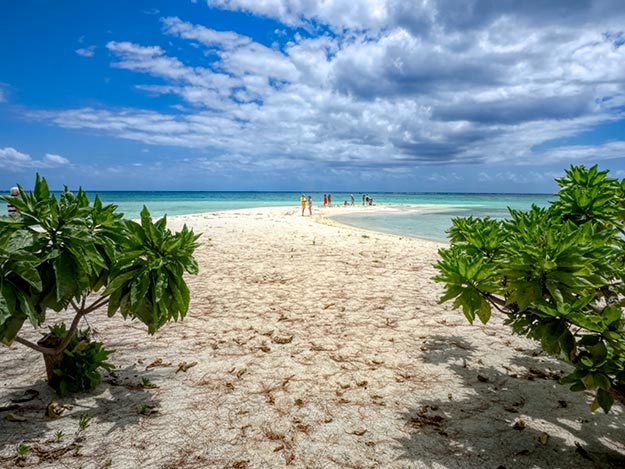
Freaked out, I looked for an escape but there was none, so I just continued to swim calmly ahead. The sharks stayed with me, in one instance coming as close as six inches away. I could have reached out and stroked their backs but I didn’t. Since they are used to being fed I didn’t want them to mistake my fingers for food. The more I swam in and out of the groups of sharks, the more I relaxed, so it hardly fazed me when a couple of enormous manta rays swam beneath and next to me. Apparently this breed of shark is not at all aggressive. They seemed more curious than anything. The experience will forever rank on my list of top ten things that everyone should do.
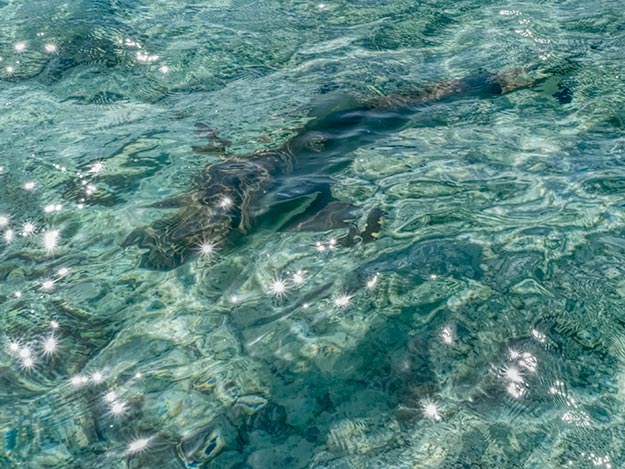

While The Tuamotus and the Society Islands were fascinating, the Marquesas were the undisputed highlight of the cruise. The Aranui 5 not only visited the six inhabited islands in the Marquesas group, it delivered freight and supplies to each of them. Within minutes of docking, the seamen began offloading everything from bundles of tarred telephone poles to appliances, drums of diesel fuel, refrigerated cargo containers, non-perishable foods and supplies, and even pickup trucks and fishing boats. It was fascinating to watch the locals pick up supplies they had ordered or vehicles they’d had shipped from Tahiti. At one point, a horse was winched onboard and dropped off on another island the next day!
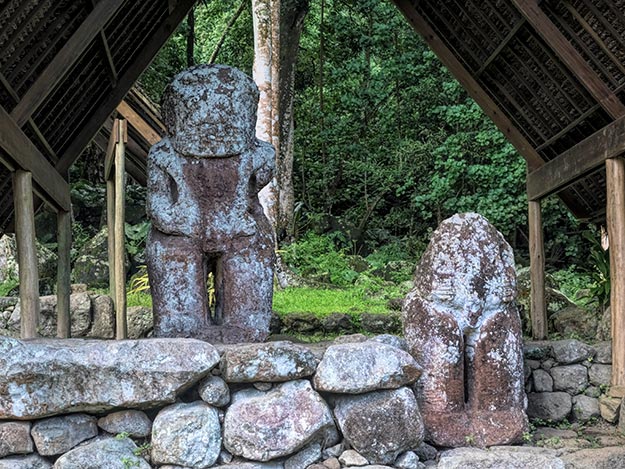

Each of the six Marquesan islands also afforded opportunities to learn about the culture. On Hiva-Oa we visited an ancient funerary site that is home to the largest stone carved Tikas in French Polynesia. The oldest, an eight-foot tall standing figure carved from red tuff lava, seems to be smiling; it is the only smiling Tiki ever discovered. Nearby is another one-of-a-kind, a reposing female Tiki. She is said to be lying down because she died in childbirth. Today, pregnant local women pray to it for a healthy, safe birth.
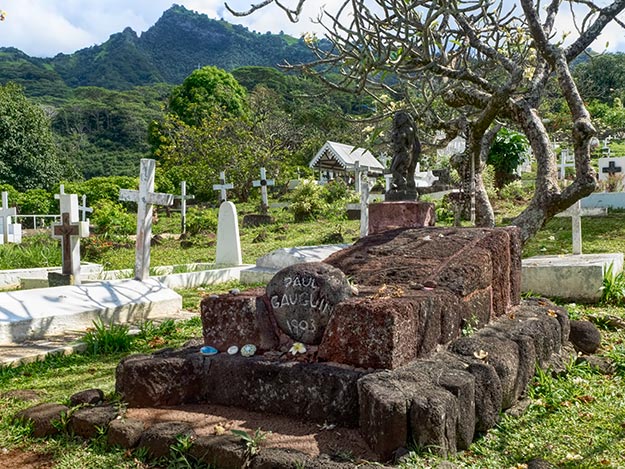
Hiva-Oa is also famous as the island where the artist Paul Gaugin spent his latter years. We visited his grave in the local cemetery, as well as the local Gaugin Museum, which contains a collection of poor reproductions of his work. However, we were treated to a lecture by a local expert who fascinated us with stories about Gaugin’s drug use, sexual exploits, debts, and his constant bickering with locals.
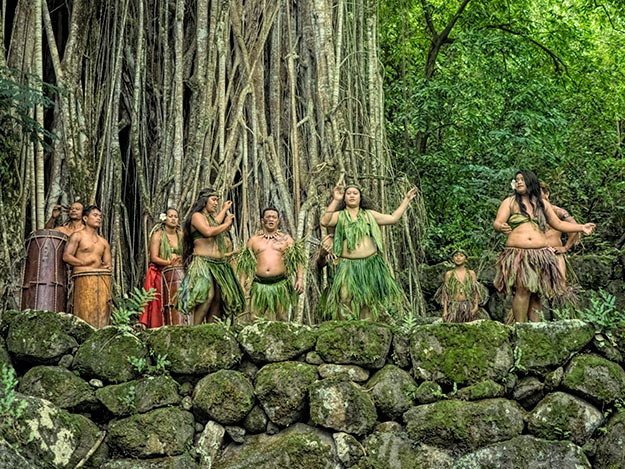
On Nuku-Hiva island I stood in front of a Banyan so gigantic that I couldn’t see the top, no matter how far back I craned my neck. My treetop reverie was interrupted by violent guttural grunts that sent shivers down my spine. This was the traditional Marquesan Pig Dance, performed atop an elevated stone platform at the base of the tree. To the accompaniment of deep-throated drums, the dancers shouted He! Ho! Over and over, the dancers rushed forward, as if preparing to attack. Their faces wore horrific, menacing expressions and their eyeballs rolled up so far into their sockets that only the whites were visible. Though no explanation was ever provided for why the Pig Dance is performed, I’m guessing it has something to do with the abundance of wild pigs found on the island and the need to whip themselves into a frenzy before hunting these dangerous animals.
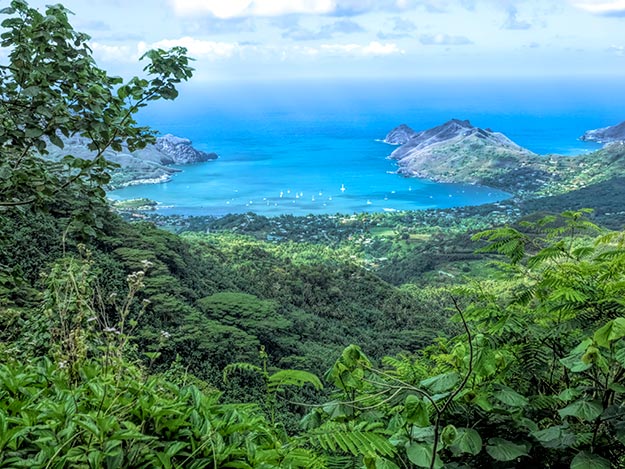
Later that same afternoon I had evidence that my theory may be correct. Following a brief stop at a mountain overlook, we arrived at a covered pavilion for a traditional Marquesan feast. The meal had been prepared in an Umu, an underground earth oven where the food is slow-cooked for hours. When the oven was opened it revealed a an entire pig, split down the center and roasted to a golden brown. As a vegetarian I couldn’t sample the pork or the goat cooked in coconut milk, but I chowed down on delicious roasted white and purple sweet potatoes, manioc, taro, breadfruit, and bananas swimming in coconut milk.
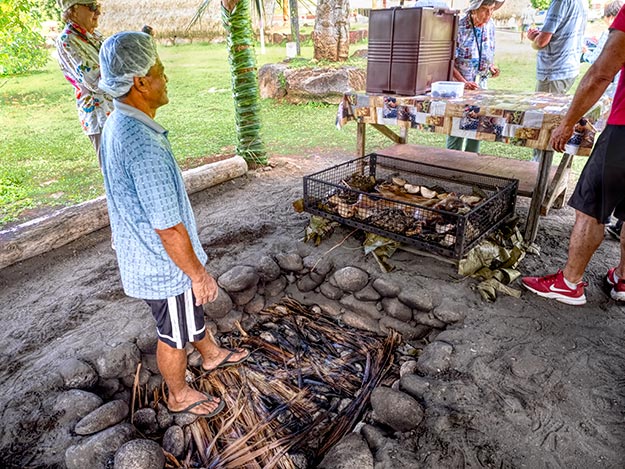
On the island of Fatu Hiva, I learned about Tapas, a natural parchment made by pounding the bark of local trees. Three different trees are used, each of which produces a different color parchment. Brown ones come from the Banyan tree, white ones are from the Paper Mulberry tree, and tan parchments are made from Breadfruit tree bark. The women of Fatu Hiva started making Tapas to raise money to pay for the education of their children because the men were always too drunk to work. These days, they also do demonstrations of how the parchment is produced.
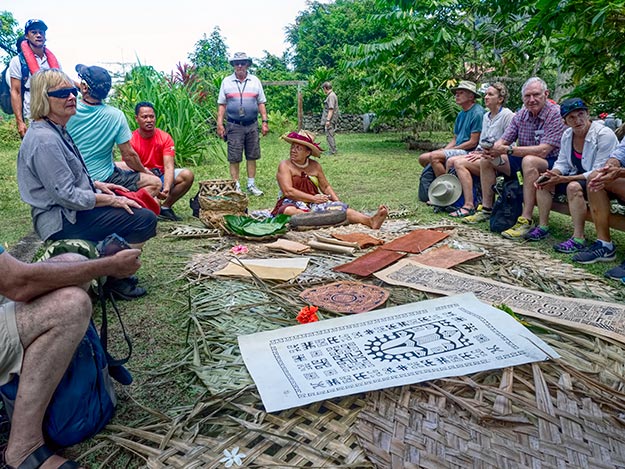
We were lucky. Our artisan was Mama Sara, who is in charge of all the Tapa crafters on the island. She removed the outer bark from a branch with a razor sharp machete. Very carefully, she made a vertical cut into the inner bark and peeled it off. Laying it on a stone slab, she began pounding it with a wooden board about the size of a 2×4. When it was tissue thin, she folded it in half and pounded it flat again. After repeated pounding, the parchment is dipped in a solution of corn starch and water and hung in the shade for one day. When dry, the women decorate it with traditional spiritual and protective symbols using ink made from candle nuts.
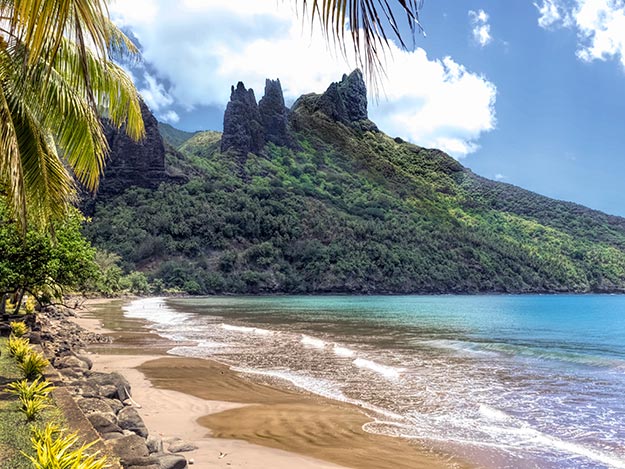
Aside from being pretty, Tapas are an important element in Marquesan culture. When a couple is about to be married, the grandparents buy a large sheet of the raw, pounded Tapa. They put it in a bowl with coconut milk, curcuma (ginger flower), and as many other blossoms as they can find, and leave it to soak and absorb the fragrance. The finished parchment is wrapped in banana leaves, placed in a hand-woven basket, and given to the couple. After their first intercourse, they gather up the sperm and place it on the Tapa, which is released into the river as an offering to the gods to ensure their fertility.

My cultural cravings satisfied, I spent the rest of the day soaking up the stunning scenery on Fatu Hiva. Unlike their cousins in the Tuamotus and Society Archipelagos, the Marquesas are geologically young, with barely eroded volcanic cones at their center and no protective rings of coral. Villages like Hanavave are tucked into isolated valleys between jagged peaks carpeted with lush green vegetation. For two idyllic hours I wandered the back roads of Hanavave, stopping to chat with locals who peel coconuts for a living and peeking into a greenhouse where vanilla was being grown. Both enterprises rely on Aranui to pick up and deliver their products.

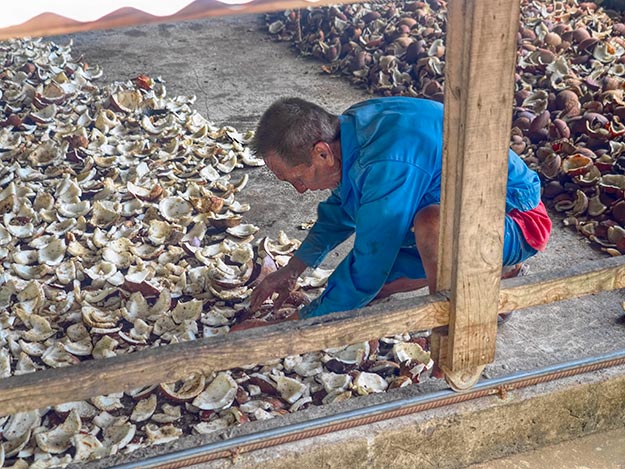
Eventually I made my way down to the dock and caught the barge back to the ship. As we sped away I had a perfect view of a famous rock formation that looms over the town. Known as “The Virgin,” it definitely looked like a Madonna figure to me. Others, however, see a phallic figure. In fact, the bay was originally named “Bay of Penis.” Horrified missionaries renamed both the bay and the rock outcropping.
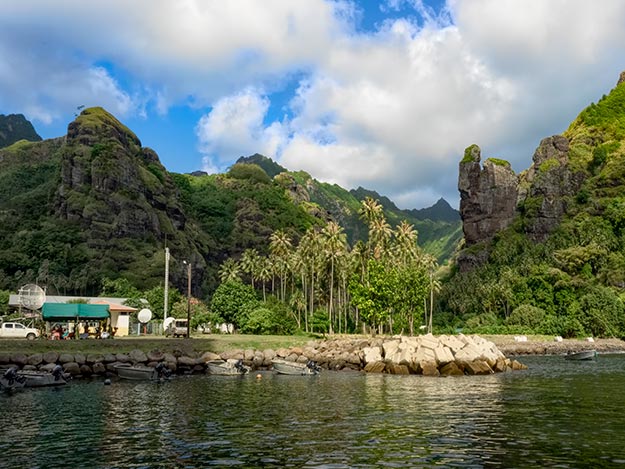

My favorite destination in the Marquesas was Ua Pou island, which is famous for the rock pinnacles that provide a sensational backdrop to the village of Hakahau. The crew had warned us that these “pitons,” as they are commonly known, are usually obscured by clouds, so I had no expectations. I was finishing breakfast as we tied up to the dock. Excitement suddenly radiated through the dining room. “You are SO lucky,” exclaimed one of the servers. We all rushed to the windows for our first view of the pitons, crystal clear against a robin’s egg blue sky.
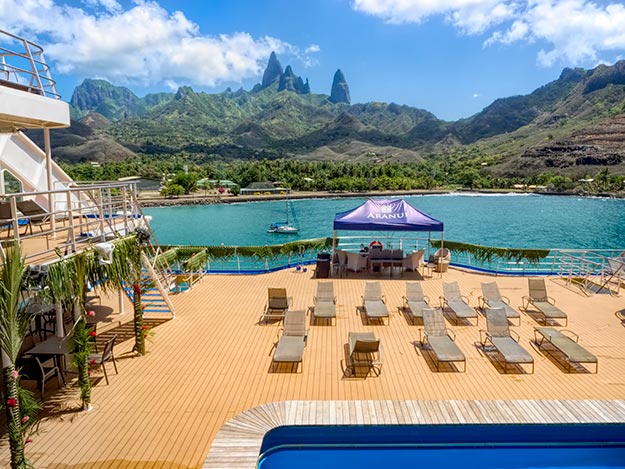
From there, the day only got better. At the local handicrafts market I found a Tika carved from cow bone that featured the Marquesan Cross at its center. The artist was covered from head to toe in traditional tattoos and he was happy to let me take his photo. But the pièce de résistance was a performance of the traditional Haka dance. Similar to the war dance of the indigenous Maori in New Zealand, the raw ferocity of the dance was meant to intimidate and terrify enemies. In addition to rolling back their eyes, the tattoo-covered warriors emitted blood-curdling screams and brandished wooden stakes with sharpened tips. It wouldn’t have surprised me to learn the tips were coated in poison.
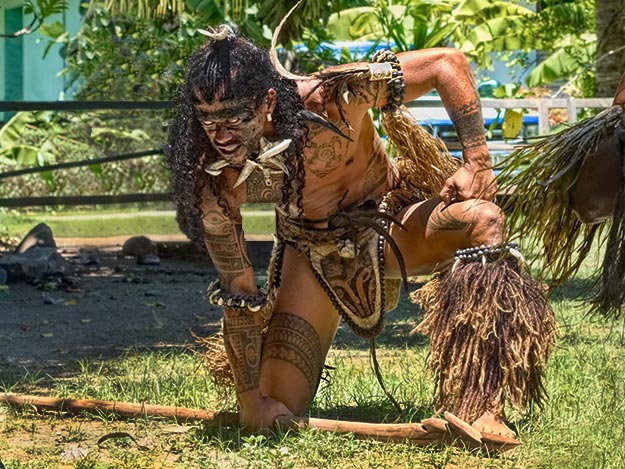
I was so mesmerized that I stopped taking photos and just watched. It’s a good thing I did. One of the performers jumped off the stage and landed inches from the man standing next to me, who had been shooting closeups with a long lens. I nearly jumped out of my skin. Had I been taking photos, I would have dropped my camera.
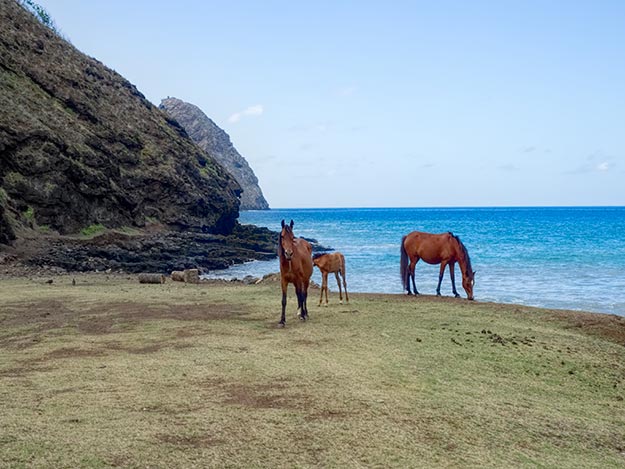
Since returning from my French Polynesia cruise, many of my followers have asked me if I would recommend the voyage. My answer is yes, without hesitation. With room for approximately 254 passengers, the ship never feels crowded and shore activities never feel like cattle drives. And if my word is not good enough for you, how about a second opinion. National Geographic named Aranui 5 as one of the top 21 best cruises in the world. I couldn’t agree more.
Disclosure: I was a guest of Aranui during my French Polynesia cruise. However, the receipt and acceptance of complimentary items or services will never influence the content, topics, or posts in this blog. I write the truth, the whole truth, and nothing but the truth.

IN 1989 THERE WERE ONLY 20 OR LESS TOURIST CABINS NOT 108 B ELIEVE ME I AM 98 AND WAS IN ONE THEY ALL HAD UPPER AND LOWER BUNKS I SHARED WITH A FRENCH LADY SHE WITH NO ENGLISH AND ME WITH SCHOOL BOOK FRENCH AND TERRIBLE FRENCH ACCENT ALSO THE CAPTAIN THEN WORE A FELT HAT A PAREA AND FLIP FLOPS HAVE A PHOTO OF THIS THIS IS ONE OF THE REMAINING RELATIVELY UNSPOILED DESTINATIONS P.S. THE FOOD WAS INCREDIBLE WAY BACK THEN PPS THE CHICKENS PIGS AND ALL ANIMALS ON MAIN DECK AND WOULD OFF LOAD AT THE VARIOUS ISLANDS, HEARING ROOSTER AT SEA IS REALLY STRANGE
Hi Wilma: Thanks so much for your comment. Your memories are so interesting. I’m glad to know that it was then, and still remains, one of the most unspoiled destinations in the world, and I feel fortunate to have visited there.
What an interesting post about a part of the world I know shamefully little about. And what beautiful photos! Thank you for sharing.
Thanks so much for your kind comment Kat. Glad you enjoyed my story.
A beautiful and extremely comprehensive article with corresponding photos. Thanks so much Barbara for the virtual vacation from my easy-chair. Now I am excited to look at the online site. I am not a cruise ship person but this type of cultural travel looks fascinating.
Thanks again for a fantastic travel blog!
Thank you SO much, Donna! Your words mean more than you can know.
Barb,
It was so nice that we got a chance to have lunch with you before you ventured on this trip. Seeing all the beautiful photographs taken by you are simply amazing. I look forward to seeing more from you.
Thank you so much Frances! It was a real pleasure to have lunch with you and Mike.
Great review and such a beautiful story. Aranui has been on my list for ages…just so hard to get there from Germany. But maybe 2020 😉
Ah Norman! I have a suggestion for you. It is a long trip, but now it can be done much more affordably with French Bee. They began service to Tahiti just a few months ago. They fly out of Paris and San Francisco and are much more reasonably priced than other carriers.
Informative with great pictures too! Thanks Barbara that was a joy to read.
Thank you very much Karen. I worried about it being so long, but many people are commenting here and on social media that they really enjoyed reading it.
is it affordable? How do I find out about it?
Hi Sharon: They have all sorts of accommodations, from four and eight-bed dorms to bottom deck rooms with portholes to ultra-luxurious suites with balconies. It’s best you contact them directly for a price quote. I’ve linked to their website at the top of the article I wrote, but it”s: http://aranui.com/
Sign me up! I want to do this too. You make it sound so inviting!
Libbie
It was fantastic Libbie. I’m sure you’d enjoy it.
Great article Barb.
Thanks Butch! I think it was the longest one I’ve ever written.